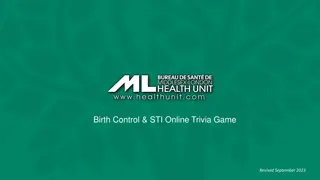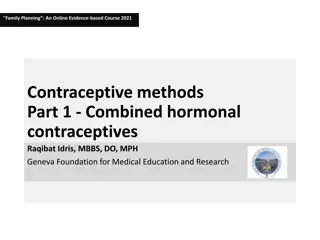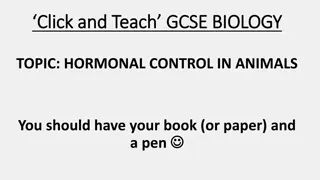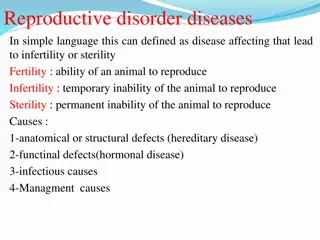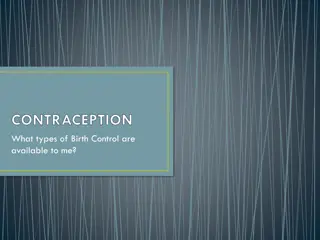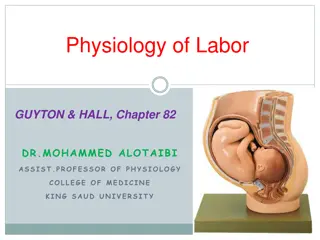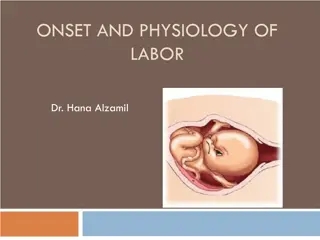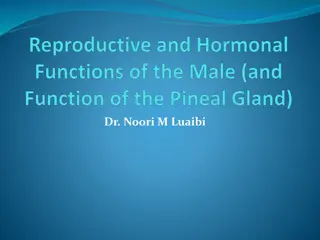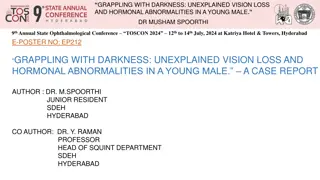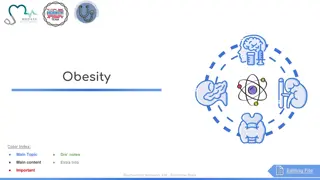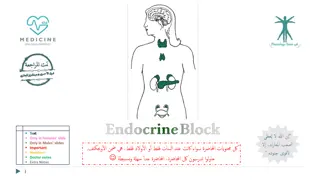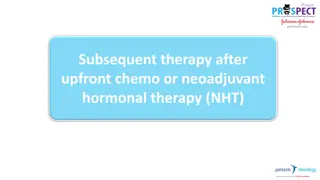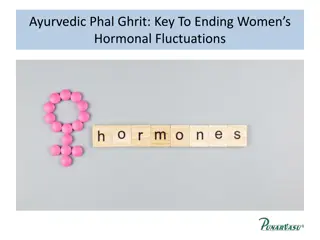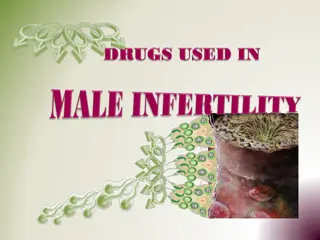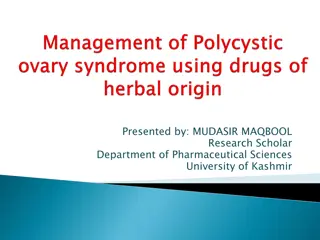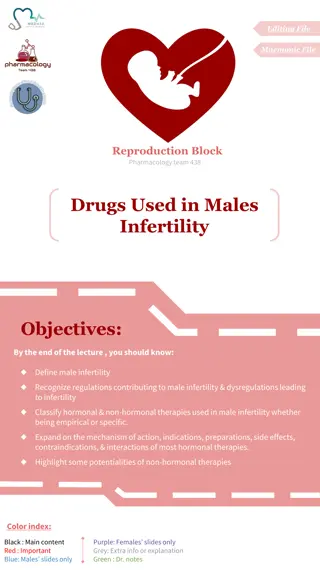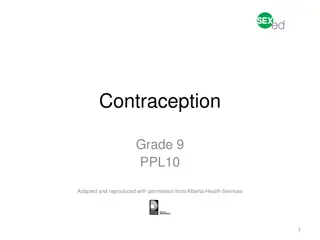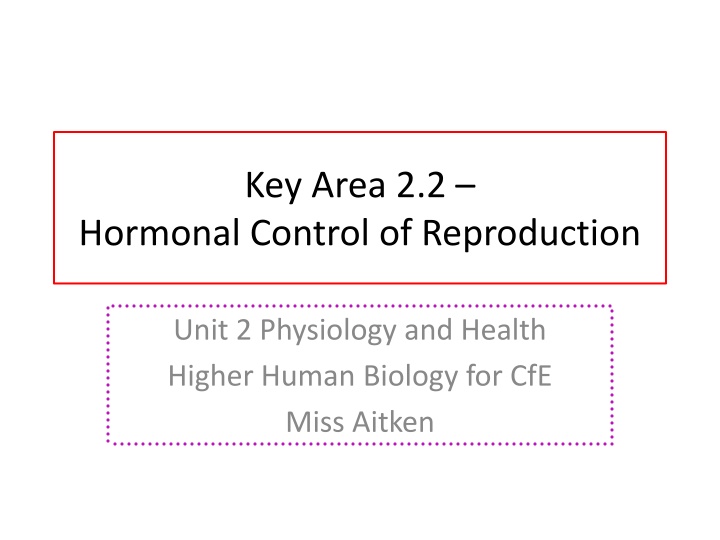
Hormonal Control of Reproduction in Puberty and Adults
Explore the fascinating process of puberty and hormonal control of reproduction in humans, including the onset of puberty, hormonal effects on sperm production, menstrual cycle in females, and ovulation. Gain insights into the roles of FSH, LH, testosterone, and progesterone in the development and regulation of reproductive functions.
Uploaded on | 1 Views
Download Presentation

Please find below an Image/Link to download the presentation.
The content on the website is provided AS IS for your information and personal use only. It may not be sold, licensed, or shared on other websites without obtaining consent from the author. If you encounter any issues during the download, it is possible that the publisher has removed the file from their server.
You are allowed to download the files provided on this website for personal or commercial use, subject to the condition that they are used lawfully. All files are the property of their respective owners.
The content on the website is provided AS IS for your information and personal use only. It may not be sold, licensed, or shared on other websites without obtaining consent from the author.
E N D
Presentation Transcript
Key Area 2.2 Hormonal Control of Reproduction Unit 2 Physiology and Health Higher Human Biology for CfE Miss Aitken
Puberty Puberty is the sequence of changes in which an individuals body develops from a child into an adult. Puberty can happen at any age between 8-16 but typically tends to be around 11-13 in females and 12-14 in males
Hormonal Onset of Puberty At puberty, the hypothalamus in the brain secretes a releaser hormone which targets the pituitary gland. The pituitary gland then begins to secrete Follicle Stimulating Hormone (FSH) and Luteinising Hormone (LH) in females, and FSH and Interstitial Cell Stimulating Hormone (ICSH) in males. This starts off the menstrual cycle in females and sperm production in males.
Hormonal Control of Sperm Production ICSH stimulates interstitial cells to produce testosterone In turn, this stimulates the seminiferous tubules, so sperm is now made inside the seminiferous tubules. If testosterone levels in the blood increase above a certain level, testosterone molecules inhibit the production of ICSH and FSH from the pituitary gland. This decreases the level of testosterone released from the interstitial cells.
Menstrual Cycle in Females In females, FSH stimulates the development of one Graafianfollicle at a time. The Graafian follicle then begins to produce oestrogen (previous lesson). LH triggers ovulation, where the egg is released from the graafian follicle into the oviduct. After ovulation, LHstimulates the corpusluteum to release progesterone.
Ovulation Each egg cell is surrounded by a Graafianfollicle which protects the maturing egg and produces oestrogen. Ovulation is the release of a mature egg into the oviduct, where it may be fertilised by a sperm cell to become a zygote. The zygote will divide by mitosis to form an early embryo as it continues along the oviduct and enters the uterus, where it implants in the womb lining to continue it s development. Following ovulation, the Graafian follicle develops into a corpusluteum, which secretes progesterone.
Hormonal Control of the Menstrual Cycle Each menstrual cycle lasts approximately 28days in the majority of women. This is divided into two 14-day phases: Phase 1 Follicular phase Phase 2 Luteal phase
Follicular Phase FSH stimulates one follicle to mature and secrete oestrogen. It continues to grow and develop until approximately day 14. During this time, oestrogen stimulates the endometrium to repair itself and prepare for implantation. Cervical mucus also becomes thinner, allowing it to be easily penetrated by sperm cells. Around day 14, LH stimulates the follicle to break open and release an egg into the oviduct.
Luteal Phase The remaining cells of the follicle develop into the corpusluteum. Progesterone acts on the endometrium and vascularisation begins, which means it grows thicker and more blood vessels appear. This is to prepare it for implantation of an early embryo. Cervical mucus begins to thicken. An embryo develops from a zygote. This implants in the lining of the endometrium 8-13 days after fertilisation.
Negative Feedback in Females High progesterone levels have a negative feedback effect on the pituitary gland, which inhibits the production of FSH and LH. Lack of FSH stops folliclesdeveloping. Lack of LH leads to a breakdown of the corpus luteum, which drops progesterone levels, leading to menstruation (a period), allowing the cycle to start again.
Hormones in the Menstrual Cycle Copy the table from the middle of HTP textbook page 72. This table gives a summary of the hormones associated with the menstrual cycle, their site of production, and their function.
No fertilisation If fertilisation does not take place, the corpus luteum breaksdown. Progesterone and oestrogen levels decrease. A low level of progesterone and oestrogen result in the inner layer of the endometrium breaking away, and menstruation occurs. Fertilisation can be unsuccessful for a number of reasons.
Fertilisation and Pregnancy If fertilisation does occur, the corpus luteum continues to produce progesterone, maintaining the lining of the endometrium and preventing miscarriage. The placenta takes over the production of progesterone a few weeks into pregnancy. The high levels of progesterone carry out negative feedback inhibition on the pituitary gland so no more FSH and LH are produced.
Past Paper Question Explain the menstrual cycle under the following headings: Follicular Phase (5) Luteal Phase if fertilisation does not occur (5)
Past Paper Question Follicular Phase: FSH stimulates development of a follicle (1) Follicle releases the hormone oestrogen (1) Oestrogen stimulates endometrium, preparing it for implantation (1) Cervical mucus becomes thinner/temp rise (1) Follicle grows and develops over approximately 14 days, after which a surge in LH causes ovulation to occur (1) the repair of the
Past Paper Question Luteal Phase: Remaining cells of follicle develop into corpus luteum(1) Corpus luteum secretes progesterone(1) Progesterone vascularises the endometrium and prepares it for implantation(1) Cervical mucus becomes thicker/temp fall (1) Corpus luteum breaks down, progesterone and oestrogen fall occurs(1) and menstruation
Past Paper Question Give an account of the role of female hormones under the following headings: Pituitary hormones (FSH & LH) (4) Ovarian hormones (Oestrogen and Progesterone) (4)
Past Paper Question Pituitary gland: FSH stimulates the development of one Graafian follicle at a time. (1) The Graafianfollicle then begins to produce oestrogen (1) LH triggers ovulation, where the egg is released from the graafian follicle into the oviduct. (1) After ovulation, LHstimulates the corpusluteum to release progesterone. (1)
Past Paper Question Ovarian hormones: oestrogen stimulates the endometrium to repair itself and prepare for implantation. (1) Oestrogen makes cervical mucus become thinner, allowing it to be easily penetrated by sperm cells. (1) Progesterone acts on the endometrium and vascularisation begins, which means it grows thicker and more blood vessels appear. (1) Progesterone also causes cervical mucus to thicken (1) High progesterone levels have a negative feedback effect on the pituitary gland, which inhibits the production of FSH and LH. (1)
Now do the questions on page 73 of the How to Pass textbook
How is puberty started? What happens if fertilisation DOES NOT take place? Role of Hormones: FSH (males) ICSH Testosterone FSH (females) LH Oestrogen Progesterone What happens if fertilisation DOES take place? Key Area 2.2 Hormonal Control of Reproduction Negative feedback: Testosterone Progesterone Stages of the menstrual cycle


